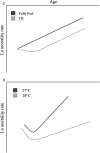Being cool: how body temperature influences ageing and longevity
- PMID: 25832892
- PMCID: PMC4486781
- DOI: 10.1007/s10522-015-9571-2
Being cool: how body temperature influences ageing and longevity
Abstract
Temperature is a basic and essential property of any physical system, including living systems. Even modest variations in temperature can have profound effects on organisms, and it has long been thought that as metabolism increases at higher temperatures so should rates of ageing. Here, we review the literature on how temperature affects longevity, ageing and life history traits. From poikilotherms to homeotherms, there is a clear trend for lower temperature being associated with longer lifespans both in wild populations and in laboratory conditions. Many life-extending manipulations in rodents, such as caloric restriction, also decrease core body temperature. Nonetheless, an inverse relationship between temperature and lifespan can be obscured or reversed, especially when the range of body temperatures is small as in homeotherms. An example is observed in humans: women appear to have a slightly higher body temperature and yet live longer than men. The mechanisms involved in the relationship between temperature and longevity also appear to be less direct than once thought with neuroendocrine processes possibly mediating complex physiological responses to temperature changes. Lastly, we discuss species differences in longevity in mammals and how this relates to body temperature and argue that the low temperature of the long-lived naked mole-rat possibly contributes to its exceptional longevity.
Figures


Similar articles
-
Nutrients and ageing: what can we learn about ageing interactions from animal biology?Curr Opin Clin Nutr Metab Care. 2016 Jan;19(1):19-25. doi: 10.1097/MCO.0000000000000234. Curr Opin Clin Nutr Metab Care. 2016. PMID: 26485336 Review.
-
The naked mole-rat response to oxidative stress: just deal with it.Antioxid Redox Signal. 2013 Oct 20;19(12):1388-99. doi: 10.1089/ars.2012.4911. Epub 2012 Dec 7. Antioxid Redox Signal. 2013. PMID: 23025341 Free PMC article. Review.
-
Stress resistance in the naked mole-rat: the bare essentials - a mini-review.Gerontology. 2012;58(5):453-62. doi: 10.1159/000335966. Epub 2012 May 10. Gerontology. 2012. PMID: 22572398 Free PMC article.
-
Methusaleh's Zoo: how nature provides us with clues for extending human health span.J Comp Pathol. 2010 Jan;142 Suppl 1(Suppl 1):S10-21. doi: 10.1016/j.jcpa.2009.10.024. Epub 2009 Dec 4. J Comp Pathol. 2010. PMID: 19962715 Free PMC article. Review.
-
Disparate patterns of age-related changes in lipid peroxidation in long-lived naked mole-rats and shorter-lived mice.Aging Cell. 2006 Dec;5(6):525-32. doi: 10.1111/j.1474-9726.2006.00246.x. Aging Cell. 2006. PMID: 17129214
Cited by
-
Development of a Rat Clinical Frailty Index.J Gerontol A Biol Sci Med Sci. 2017 Jul 1;72(7):897-903. doi: 10.1093/gerona/glw339. J Gerontol A Biol Sci Med Sci. 2017. PMID: 28158648 Free PMC article.
-
Alternative splicing coupled mRNA decay shapes the temperature-dependent transcriptome.EMBO Rep. 2020 Dec 3;21(12):e51369. doi: 10.15252/embr.202051369. Epub 2020 Nov 2. EMBO Rep. 2020. PMID: 33140569 Free PMC article.
-
The effects of graded levels of calorie restriction: IX. Global metabolomic screen reveals modulation of carnitines, sphingolipids and bile acids in the liver of C57BL/6 mice.Aging Cell. 2017 Jun;16(3):529-540. doi: 10.1111/acel.12570. Epub 2017 Jan 31. Aging Cell. 2017. PMID: 28139067 Free PMC article.
-
DNA repair and anti-cancer mechanisms in the long-lived bowhead whale.bioRxiv [Preprint]. 2024 Nov 5:2023.05.07.539748. doi: 10.1101/2023.05.07.539748. bioRxiv. 2024. PMID: 39574710 Free PMC article. Preprint.
-
The longevity response to warm temperature is neurally controlled via the regulation of collagen genes.Aging Cell. 2023 May;22(5):e13815. doi: 10.1111/acel.13815. Epub 2023 Mar 9. Aging Cell. 2023. PMID: 36895142 Free PMC article.
References
-
- Andrews MT. Advances in molecular biology of hibernation in mammals. BioEssays. 2007;29:431–440. - PubMed
-
- Angilletta MJ, Jr, Steury TD, Sears MW. Temperature, growth rate, and body size in ectotherms: fitting pieces of a life-history puzzle. Integr Comp Biol. 2004;44:498–509. - PubMed
-
- Bartke A, Coschigano K, Kopchick J, Chandrashekar V, Mattison J, Kinney B, Hauck S. Genes that prolong life: relationships of growth hormone and growth to aging and life span. J Gerontol Ser A Biol Sci Med Sci. 2001;56:B340–B349. - PubMed
Publication types
MeSH terms
Grants and funding
LinkOut - more resources
Full Text Sources
Other Literature Sources
Medical

